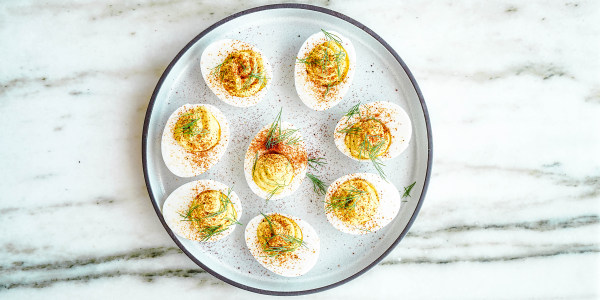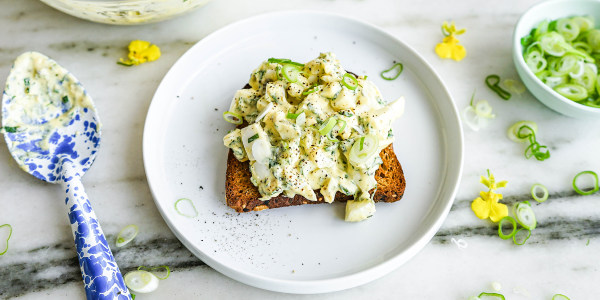Chef Elena Besser, host of "Breakfast with Besser" on Food Network, is once again joining TODAY to solve viewers' kitchen conundrums. She shows us how to make perfectly eggsecuted scrambled, poached, fried and hard-boiled eggs and shares her recipes for a lighter, no-mayo egg salad and easy deviled eggs.
Do eggs really need to be stored in the refrigerator?
Yes, it's always recommended to keep eggs refrigerated, but some recipes (especially in baking) call for room-temperature eggs. You can quickly bring eggs to room temp by putting them in a glass of hot water.
How to cook scrambled eggs
- Your first step is to add salt to the eggs before you cook them. Doing this will help your eggs stay super fluffy while they cook because the salt acts as a buffer between the proteins in the egg, so they don't tighten up — science!
- Now onto the pan, the heat, the fire! But don't get too excited: Scrambled eggs cook best at consistent medium-to-low heat. A lower temperature means that your eggs will cook slowly and be more custardy once they're done.
- In order to achieve custardy and delicious eggs, it's also necessary to agitate them — meaning don't leave them alone! The eggs should be constantly moving around in your pan until they're ready to be taken off the heat.
- About 30 seconds before your eggs have reached the desired consistency, remove them from the heat! The internal heat from the eggs and the heat from the pan will continue to cook the eggs a bit more and we don't want to over-cook them. You can also do this at any time during your cooking process if you think your eggs are cooking too quickly.
How to cook fried eggs
- To make the perfect fried egg, start by adding a thin layer of oil to your frying pan so that it covers the entire surface. Once the oil is hot (about 30 seconds), crack the egg into your pan. If you want a picture-perfect egg with the yolk in the center, you can use your finger to move the yolk until it sets in the desired spot.
- I always make sure to cover my pan with a lid to make sure my egg cooks evenly. The thin egg white will always cook faster than the thick egg white so covering the pan prevents having a loose egg white.
How to cook poached eggs
- When making a poached egg, it's important to know the difference between thick and thin egg white. Take a mesh strainer and crack your egg into it. The thin egg white will fall through the strainer, and you will be left with thick egg white and egg yolk. Doing this will make your poached egg is more uniform.
- Before you slide the egg into your pot of water, make sure the water is at a simmer and not boiling. If the water is boiling, the egg may break apart, and you'll be back at square one (ugh).
- Once the egg is in the water, it's important to move it around so the egg can cook evenly on all sides. You'll know the egg is ready to be flipped over when the egg white becomes slightly opaque.
- Gently take your egg out of the water after 3 to 4 minutes. Your poached egg should be set on the outside and soft and squishy on the inside.
How to make the perfect hard-boiled egg
Delicately lower the eggs into boiling water, cook for 11 to 12 minutes (11 if room-temp egg, 12 if straight out of the fridge), lower into an ice bath, chill for 4 to 5 minutes and immediately peel. It is important to peel eggs exactly 4 to 5 minutes after they have been chilling in an ice bath. I love the spoon method! Crack the egg on a flat surface and use a spoon to easily remove the shell. I find that the water from the water bath helps the shell slide off, too.
I think deviled eggs are a classic appetizer for any gathering at any time of year. My favorite tricks to make them extra special are adding a tad of vinegar for punch and some curry powder for warmth. This is my go-to when I need to bring something to a gathering but am short on time.
How to make egg salad without mayo
I love a vinaigrette-based egg salad. First, I will make a dressing with Dijon-mustard, Champagne vinegar, fresh herbs, capers, scallions and cornichons, then I will stream in olive oil and toss the eggs in the mixture for a delightful, punchy egg salad. A scoop of Greek yogurt also makes a great swap for mayo.




